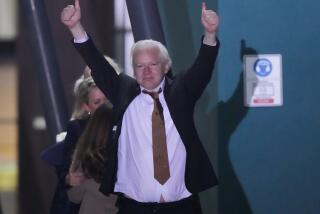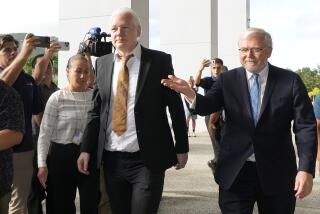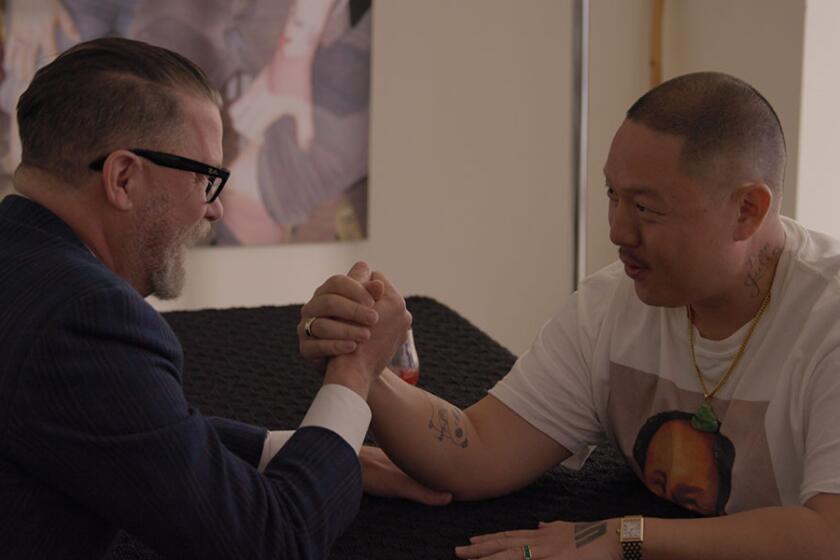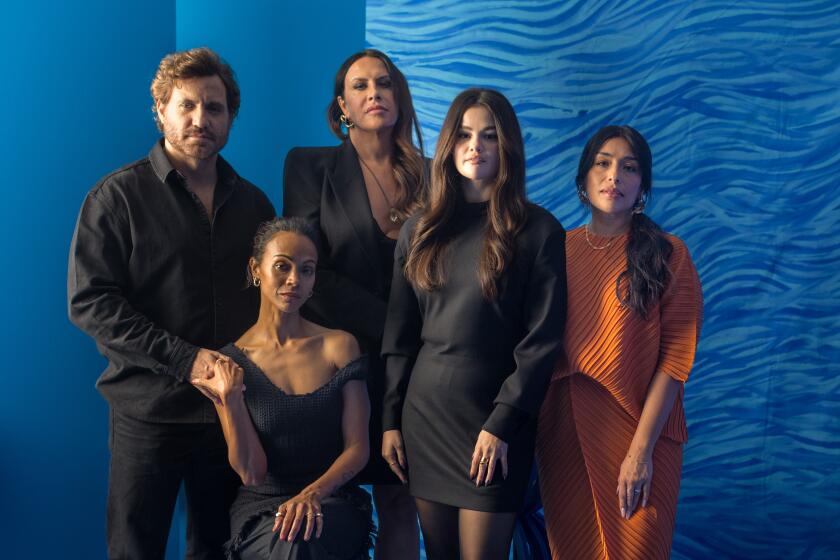Perspective: With Laura Poitras’ re-cut ‘Risk,’ a director controversially changes her mind about Julian Assange
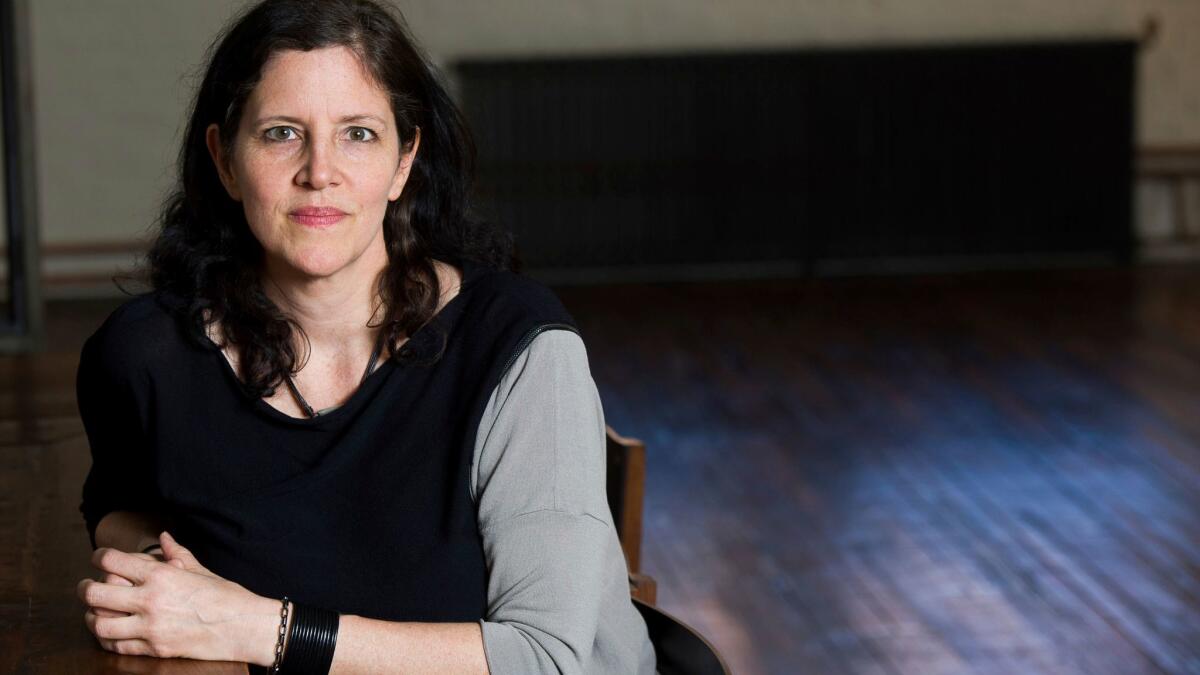
Reporting from NEW YORK — The story of WikiLeaks founder Julian Assange has been as compelling and Shakespearean as any in modern media.
But the tale of the person making a documentary about him — by his side when he called the State Department about a diplomatic-cable dump, filming him don a disguise in a London hotel room before he fled to the Ecuadorean Embassy — may be even stranger and more interesting. It’s the kind of story that raises a lot of questions, not all of them ones the filmmaker likely intended to raise.
Here’s how it unfolded. Six years ago, Oscar-winning documentarian Laura Poitras began filming Assange for a project she would eventually title “Risk.” (Her 2014 hit “Citizenfour,” about Edward Snowden, actually grew out of it.).
She first crafted the Assange material into an episodic series, showing some footage at the 2015 New York Film Festival. Then, at Cannes a year ago, she premiered a complete film — an up-close, lionizing portrait of Assange, occasionally depicting the WikiLeaks founder as a blowhard but ultimately presenting him as a maverick hero.
This weekend, “Risk” finally arrived in theaters. But the movie you will see at the cineplex is very different from the Cannes version of the film — which was so favorable toward the WikiLeaks founder that, at a glittery post-screening reception, Assange deputy Sarah Harrison attended in full celebratory mode.
A number of key changes jump out. A heroic opening in which Assange buttonholes State Department lawyers has been cut down; instead the film now essentially begins (and ends) with an interview that reveals his narcissism.
There are added snippets of Assange talking about the Swedish women who’ve accused him of sexual assault (what led to his five-year embassy stay) with contempt.
In general, Assange is depicted as more than just prickly — he is seen as highly imperious, at times pushing around staffers, other times making troubling comments about women.
REVIEW: Laura Poitras zeroes in on Julian Assange and WikiLeaks in the compelling, elusive ‘Risk’ »
But the biggest switch is the addition of Poitras’ voice, via periodic readings from her production journal from the shoot, raising doubts about Assange. What had been a favorable portrait with no commentary is now a less favorable portrait with amplified skeptical commentary.
“I didn’t trust him,” is the gist of some of these voice-overs. Not only do we see Assange in a far less flattering light than we did in the previous version of “Risk,” but we learn that Poitras didn’t have such fuzzy feelings toward him all along.
What in the name of the Freedom of Information Act is going on?
In a long conversation with Poitras earlier this week, a day after the new cut screened at a Whitney Museum premiere, she acknowledged she had made a “tougher, darker film.”
So what happened between the Cannes screening a year ago and now to make her take a more critical view of Assange?
The most obvious explanation — the one that many filmgoers heading to the ArcLight this weekend might assume — is that it was the election. Assange, of course, took an activist role in the 2016 campaign, publishing the hacked emails of the Democratic National Committee and Hillary Clinton campaign chair John Podesta. Needless to say, the source of those emails remains a matter of charged debate. (At a Senate hearing this week, FBI director James Comey called WikiLeaks “intelligence porn.)
That publishing decision — and comments in Assange’s Twitter feed that implied he relished his role — has been enough to sway even some sympathizers against him.
But that’s not actually what bothered Poitras. She includes the election development in the new cut as a kind of final chapter. Yet there is not much questioning of the ethics of Assange’s moves. In fact, when asked whether Assange’s role in the election caused her to be harder on him, she demurred.
“That wasn’t really it,” she said, then defended him with a common pro-WikiLeaks refrain — that he was less trying to bring down Clinton or even influence the election than publish whatever he could, and that he would have released Donald Trump’s tax returns if he had them too.
But if it wasn’t the Podesta emails, what tipped her over the edge?
“His manner,” she said, “was new to me.”
Wait. Surely someone who’d known Assange for so many years, who’d been in the room with him so many times, could not have been surprised by this behavior? From 2011 to 2015 he was all good, but in 2016 he finally went over the edge?
In a word, yes. Right before the Cannes screening, Assange had a long phone exchange with Poitras. (This is covered briefly in the film but she opened up about it more in the interview.) His level of upset, particularly over the inclusion of the Swedes’ accusations, was extreme. More than extreme. Irrational. And threatening. Poitras, on the record in the interview, called it “intense pressure.” It’s clear she was putting it mildly. She decided soon after to re-cut the film.
“I at first didn’t want to put myself in the movie,“ Poitras said, noting her observational style of filmmaking. “But when I went back I wanted to make a film that was honest. The production journal emerged because I felt I could bring [new] insight.”
Brenda Coughlin, Poitras’ frequent collaborator and a producer on this film, said that the pre-Cannes pressure from Assange made filmmakers look at all the old footage with fresh eyes. “You see everything differently when something like that happens,” she told me. “Laura’s feelings evolved.”
But that still leaves plenty of smoke around these embers. The production journal bits aren’t saying Poitras changed her mind after the Cannes call. She was telling us she was skeptical all along.
If Poitras knew all these things then, why did she conceal her “I don’t trust him” feelings in the earlier version of the film? Was she too close to the subject to be critical? Or was she such a believer in the politics that she downplayed her doubts, not wanting to jeopardize the greater cause? There’s no way to know. And she didn’t explain when asked. She simply repeated that she didn’t like putting herself in her films. But there are other ways to convey skepticism besides voiceover, even in observational filmmaking.
Ideology, certainly, is tough to get away from as an animating force here. “Risk” takes the question that most Americans would say is the most polarizing aspect of this affair — is the wholesale publication of leaked or classified material journalism? — and downplays it, just kind of assuming that the answer is yes.
It instead gets caught up in a secondary question: Is the man doing the publication a good or bad human being? But Assange is a means, not an end. It’s like writing an essay on the morality of nuclear weapons and spending most of it parsing the chemical properties of plutonium.
Documentarians should be allowed the luxury to revisit their subjects. They deal with fast-moving stories. They have to finish a film, and the news keeps going. Anyone who’s ever made or written about a documentary understands that. Poitras deserves credit for doing this — for her willingness to examine what she is admitting was her own naivete, at least when it came to Assange’s character.
But what makes it tougher to swallow is that she didn’t revisit the material by making a new movie, or leaving the old movie as is and updating it, the way many other journalists would do. Nor did she walk away without distributing the film, as she contemplated doing. She revisited by painting over the original, as if that naivete never existed in the first place. Chunks of the original are still there, of course. But like the divorced guy who’s covered up some of the wedding video with a football game, the spirit of the Cannes film is gone.
There’s one more complicating factor. In the new “Risk,” Poitras reveals she had a brief romantic relationship with one of the movie’s subjects: Jacob Appelbaum, an Assange acolyte and a leader in the hacker and WikiLeaks community. The disclosure was not made in the first film. But several weeks after the Cannes screening, news of it, and of multiple allegations of sexual harassment against Appelbaum, came to light.
These developments are handled quickly but cleanly in the new film, at the point when they make sense chronologically: Poitras discloses her relationship, putting it in the context of the larger scandal surrounding Appelbaum. Yes, critics would be forgiven for asking whether what we see is undermined by her romantic relationship with a subject. In her defense, Poitras’ reputation and integrity have always been stellar, and the relationship, she said when I asked, happened at least after the shooting part of production.
But Poitras’ involvement with someone in her movie reinforces an uncomfortable impression about the work — reinforces, really, the same impression all these other questions leave. When it comes to the controversial subjects of Julian Assange and WikiLeaks, the director may simply be too close to the flame.
See the most-read stories in Entertainment this hour »
Twitter: @ZeitchikLAT
ALSO
In ‘Citizenfour,’ Laura Poitras feels heat of telling Snowden’s story
More to Read
Only good movies
Get the Indie Focus newsletter, Mark Olsen's weekly guide to the world of cinema.
You may occasionally receive promotional content from the Los Angeles Times.

